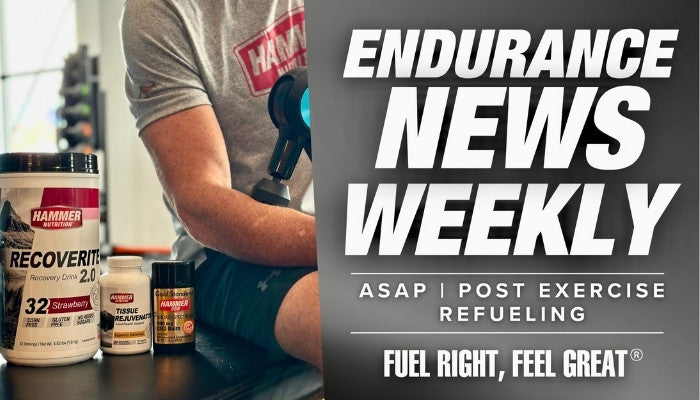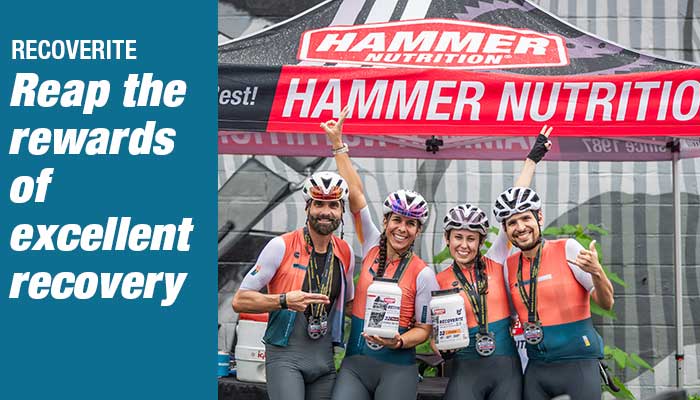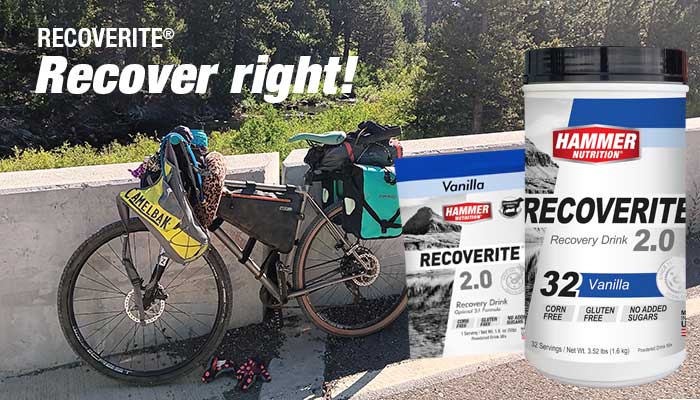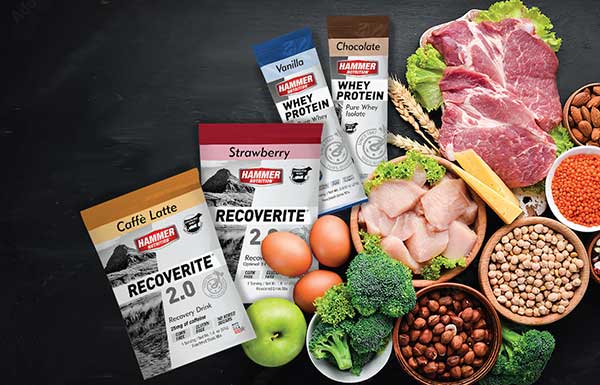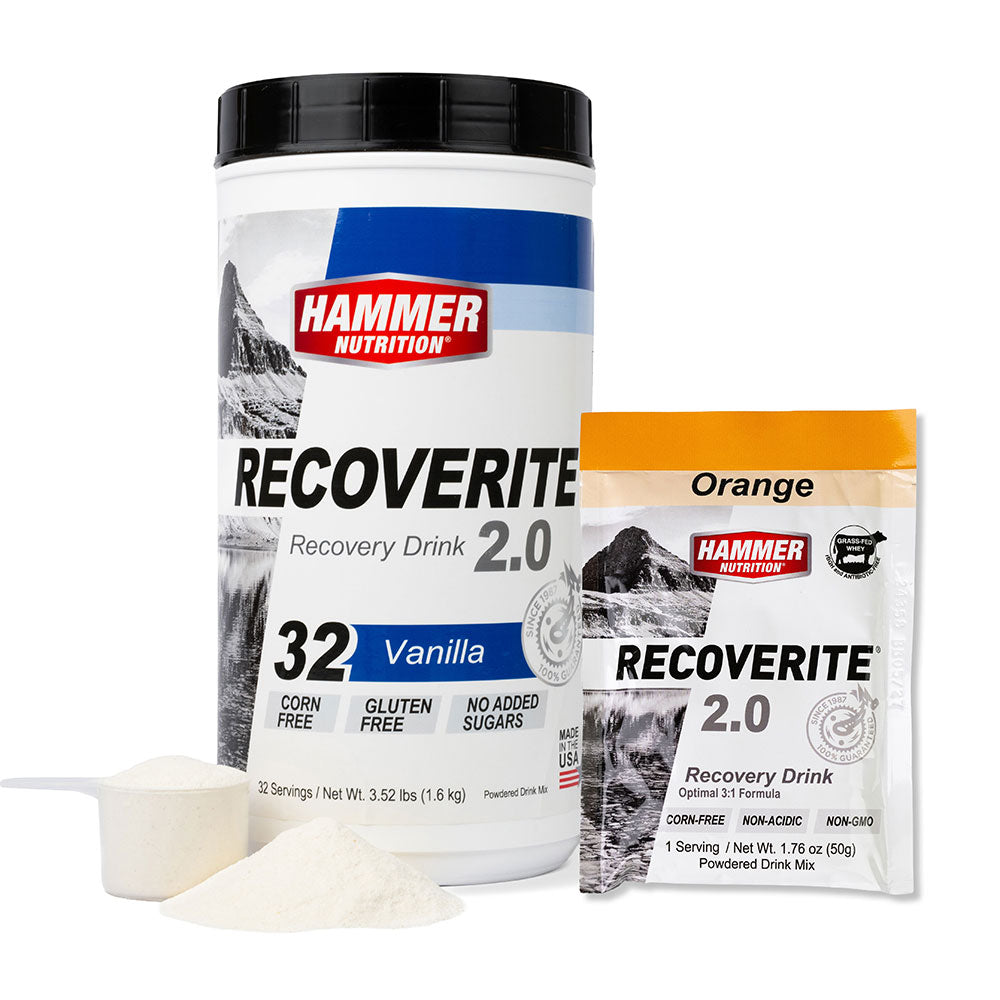
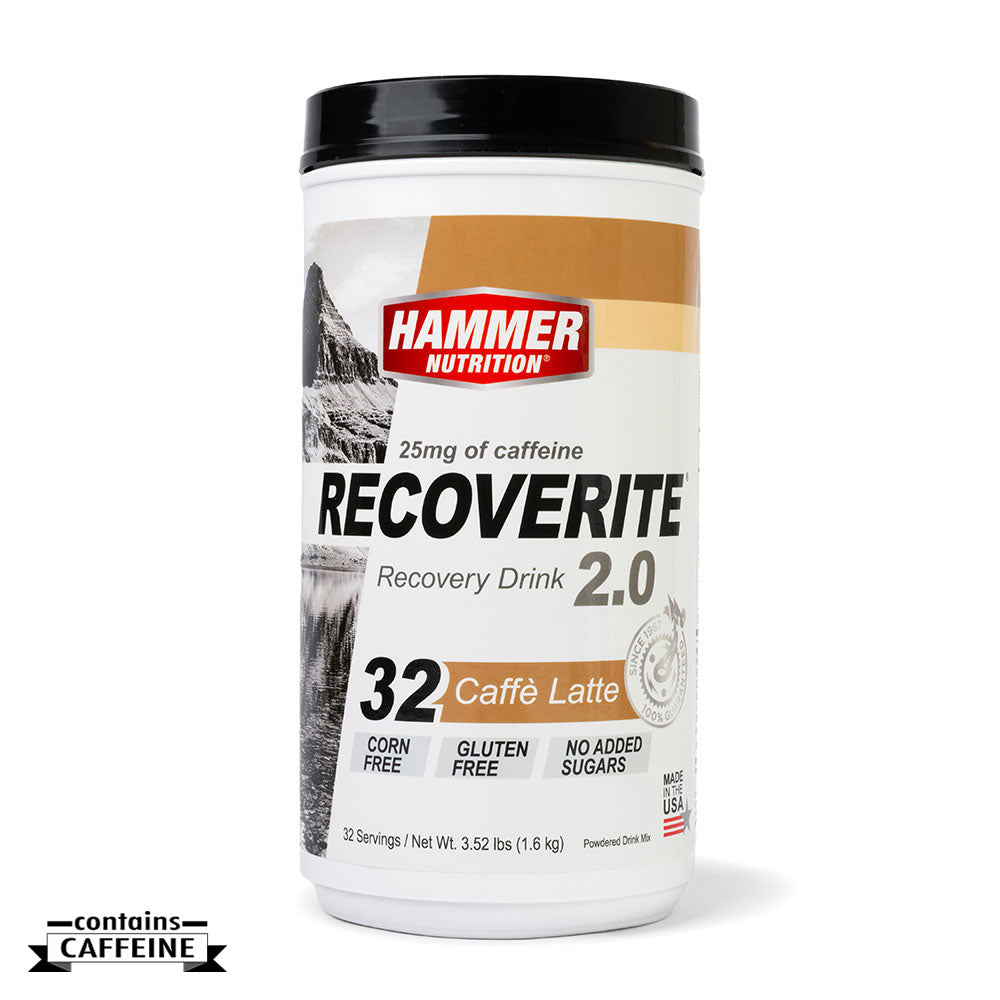
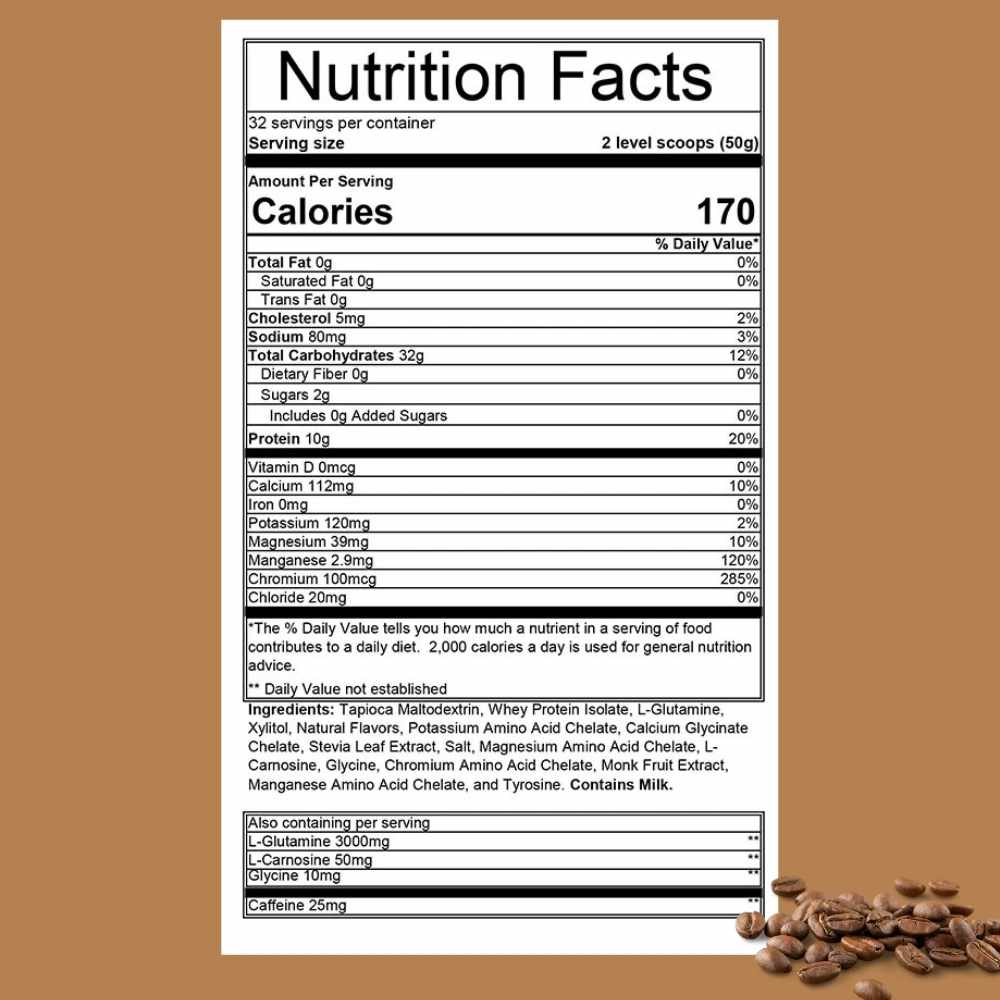
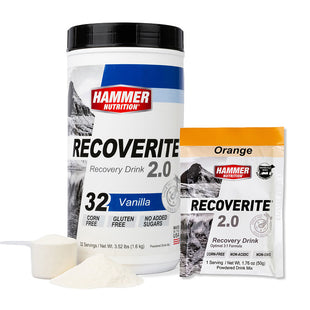

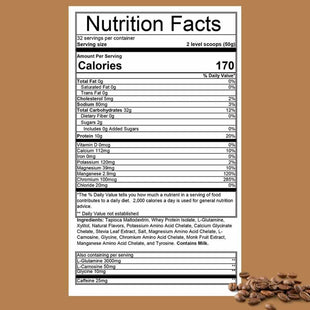
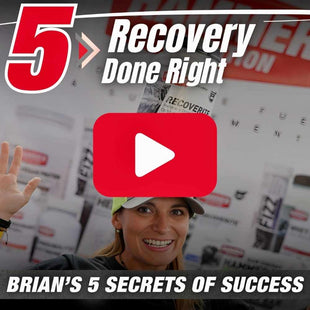
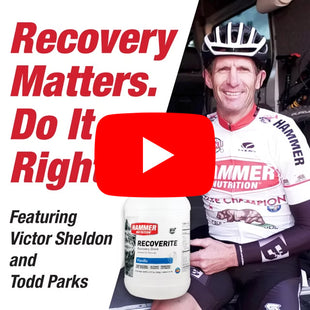
Recoverite®
- Restores muscle glycogen
- Rebuilds muscle strength
- Reduces soreness & fatigue
Also available as Vegan Recoverite
Anti-Xylitol Hype click HERE
2.0 = Tapioca, Classic = Corn
Quantity:






Highly effective and utterly delicious, Recoverite provides exactly what your body needs to reap the most from your activity—a 3:1 ratio of complex carbohydrates to premium whey protein isolate, three grams of L-glutamine, key recovery benefiting auxiliary nutrients, and a full spectrum of electrolytes.
Contains xylitol. Do not feed to your dog.
Classic Recoverite - The original fan favorite, corn based formula.
2.0 Recoverite - Updated with tapioca maltodextrin derived from cassava, a far superior energy source and it’s Paleo friendly.
Read all about it here: Six Reasons why Tapioca is TOPS!
- What is Hammer Nutrition’s response to the recent headlines about xylitol?
- Why did you switch to a tapioca-derived maltodextrin for Recoverite 2.0?
- Why do I need a recovery drink?
- What is the difference between Whey Protein and Recoverite?
- How do I determine the equivalent of one scoop of Recoverite?
- What is the amino acid profile of the whey protein isolate in Recoverite?
- Can I mix with warm water instead of cold water?
- Does Recoverite contain caffeine?
- Can I add an extra scoop of Whey Protein to Recoverite?
- Can I use Recoverite or Vegan Recoverite during a long workout or event?
- Are your products tested for heavy metals?
- What's the difference between Recoverite & Organic Vegan Recoverite?
- Why does Recoverite contain maltodextrin?
- Does the whey protein isolate in Recoverite contain lactose?
- Why do you use maltodextrin instead of sugar in your fuels?
- What is the osmolality of Recoverite?
- How much manganese in Hammer fuels?
- I have some lactose intolerance issues. Can I still use Recoverite and Whey Protein?
- How much l-glutamine is present in one serving of Recoverite?
- Is there any egg in Recoverite?
- Does Recoverite contain soy?
- Is Recoverite or Organic Vegan Recoverite manufactured in the same facility as your CBD products?
- What is the difference between whey protein isolate and whey protein concentrate?
- Does Recoverite contain antibiotics or hormones?
- Which version of HEED, Perpetuem, and Recoverite are Kosher certified?
- Is Recoverite and/or Organic Vegan Recoverite suitable for diabetics?
- Is it okay for my dog to consume Recoverite?
- What is the cause for the sharp smell when I open a container of Recoverite or Whey Protein?
- How can I prevent any clumping from happening when mixing my fuel bottles?
- Is it better to take Recoverite after a workout or before bed for optimal results?
DON’T BELIEVE THE PROPAGANDA AND THE HYPE!
Q: What is Hammer Nutrition’s response to the recent headlines about xylitol and its supposed negative effects on cardiovascular health?
A: There have been a LOT of headlines lately on xylitol, but we find that they are ALL overly sensationalistic and do not consider much of the actual xylitol study. These headlines are nothing more than scare tactics, and they do a disservice to people looking for reliable and legitimate information.
OUR POSITION: This study, just as is the case with the erythritol study, can show only an association between xylitol and heart risk, a v‑e‑r‑y weak one. It absolutely does not show that xylitol caused or causes a higher incidence of heart attack, stroke, or death.
The information provided below and other variables not accounted for in the study, would make this research more reliable. Dr. F. Perry Wilson said this about the erythritol study—performed by the same research team that did this xylitol study—and we believe it applies here as well: “We shouldn’t be thinking about the results of the study in a vacuum. Even if erythritol does truly increase the risk of heart attacks and strokes, it still is replacing sugar, which almost certainly has more pernicious health effects.”
Here are some of the “red flags” and flaws in the xylitol study:
- As xylitol is found in several fruits and some vegetables and is naturally produced by the body, calling it an artificial sweetener, as some “scientists” do, is incorrect.
- In the study, the investigators measured the level of naturally occurring xylitol in the blood of more than 3,000 participants after overnight fasting. They found that people whose xylitol levels put them in the top 25% of the study group had approximately double the risk for heart attack, stroke, or death over the next three years compared to people in the bottom quarter. This is all based on ONE collection of blood and its xylitol content.
- Xylitol content in the blood, but not xylitol intake via the diet, was considered. No history of the participants’ dietary practices before the study or in the 3-year follow-up period was mentioned in the research. Dr. Leonardo Sodre writes, “At no point did the study's author evaluate the consumption of xylitol, but rather the presence of this type of molecule in the blood.”
- The majority of the participants—average age 64 years old—were very sick to begin with. Many were overweight, had diabetes, hypertension, a history of cardiovascular disease, heart attack, coronary heart disease, stenosis (“the narrowing or restriction of a blood vessel or valve that reduces blood flow), and heart failure. Many were also taking statin medications, which, according to the American Heart Association: “lower cardiovascular event risk, yet paradoxically increase coronary artery calcification, a marker consistently associated with increased cardiovascular risks.”
- The study of naturally occurring xylitol in people’s blood was observational and can show only an association between xylitol and heart risk. It does NOT show that xylitol CAUSED a higher incidence of heart attack, stroke, or death. According to one site, “Observational studies are a lower standard of evidence than experimental studies, are more prone to bias and confounding, and cannot be used to demonstrate causality.” What would seem far more responsible clearly is the participants' health and dietary practices (the latter was not mentioned or recorded in the research).
More information, including charts outlining the participants’ health and other factors, is available upon request at support@hammernutrition.com
Why did you switch to a tapioca-derived maltodextrin for Recoverite 2.0?
Our carbohydrate-containing fuels used a corn-derived maltodextrin (complex carbohydrate), which was actually a very good maltodextrin. However, we found that tapioca (cassava root)-derived maltodextrin offers the following advantages over corn-derived maltodextrin, which is why we made the switch:
- Tapioca requires far less processing than corn.
- Unlike corn, there is no GMO content in tapioca to begin with, so even though all the corn-derived maltodextrin we used in our products tested at 0ppb for GMOs, going with tapioca just saves us that hassle.
- Tapioca maltodextrin has naturally lower amounts of sodium and higher amounts of naturally occurring potassium. Given that most everyone consumes far too much sodium as it is, having more potassium and less sodium is a definite plus.
- Tapioca maltodextrin has a more-alkaline pH than corn-derived maltodextrin. Considering that we athletes are “acid-producing machines” during exercise, a more-alkaline pH is a highly desirable during-exercise feature/benefit.
- Tapioca maltodextrin has a lower Dextrose Equivalent (DE), which means lower mono and disaccharide (short-chain sugar) content, and a much higher percentage of polysaccharide (complex carb) content--in essence, a more “complex” complex carbohydrate--for even longer-lasting energy and endurance.
- Tapioca maltodextrin has same Glycemic Index (GI) as other forms of maltodextrin, so you get the fast-acting energy that you’re looking for.
Why do I need a recovery drink?
That's where Recoverite comes in, providing unsurpassed nutritional support to ensure you obtain the maximum value from your workouts and complete recovery after each training session and race.
What we do in training is definitely important, no question about it, but if we neglect to consistently take the proper steps to recover properly, we will never get the full value out of the time and energy spent in training. Remember, the gains we make in our training occur during recovery, but only in the presence of adequate rest and optimal nutritional support. If we don’t attend to that, we not only miss out on the benefits of our workouts, we can create more problems such as getting sick or injured. The key to kick-starting the all-important recovery process is the replenishment of high-quality carbohydrates and protein immediately after exercise (within the first 30 minutes, the sooner the better). When you give your body this kind of support when it's most receptive to replenishment, which it is the minute you stop exercising, it will respond by:
- Storing more minutes of the premium, ready-to-use fuel (glycogen) in the muscle cells
- Strengthening your immune system
- Rebuilding muscle tissue stronger
- Reducing aches and soreness
Recoverite and Organic Vegan Recoverite provides your body with the ideal 3:1 ratio of carbohydrates to protein, along with generous amounts of multi-beneficial glutamine (a whopping three grams per serving!), the potent antioxidant l-carnosine, and a full-spectrum electrolyte profile. The result is rapid and enhanced recovery, allowing you to obtain the maximum value from all of your workouts and ideally prepping your body for your next workout or event.
What is the difference between Whey Protein and Recoverite and what is the best time to use either or both of these products?
Every serving (1 scoop) of Whey Protein contains 15 grams of 100% whey protein isolate and 6 grams of glutamine. For athletes doing a purely strength workout (e.g. a weight training session in the gym), consuming 1 scoop of Whey Protein immediately after the workout is a great to provide the lean muscle tissue with the amino acids it needs to repair and rebuild. The glutamine in the product, among its many benefits, is ideal for helping maintain a strong immune system. Consuming 1 scoop of Whey Protein prior to bedtime is also a highly beneficial practice—the body receives an excellent dose of amino acids, which it will use during a time (sleep) when it does many of its reparation/recuperative processes, and the glutamine will elevate serum human growth hormone (hGH) levels, which has anabolic (muscle building) effects. Lastly, a serving of Whey Protein taken any time during the day is an excellent way to bolster your daily protein intake, helping you reach your optimal amount.
Every serving (2 scoops) of Recoverite contains 10 grams of the same exact whey protein isolate that's in Whey Protein, as well as 3 grams of glutamine. Every serving of Recoverite also contains 33 grams of complex carbohydrates; Whey Protein contains only 0-1 grams of naturally occurring carbohydrates (no added carbohydrates). Unlike a "strength only" workout, immediately after an aerobic/endurance workout the body needs these carbohydrates to replenish and increase depleted glycogen stores. Both the protein and glutamine components in Recoverite assist in the glycogen restoration process. The protein also supplies the amino acids needed to help repair and rebuild the muscle, and the glutamine supports healthy immunity. Recoverite (but not Whey Protein) also contains the trace mineral chromium polynicotinate (ChromeMate®), which maximizes insulin functioning (very important in the glycogen restoration process), and l-carnosine, which is a powerful antioxidant.
How do I determine the equivalent of one scoop of Recoverite?
No scoop? No problem! With the following conversion information, your "Where did my scoop go?" problems are resolved!
Recoverite 2.0
1 Level Scoop (50 cc) = 3 TBSP + 1 tsp (Serving Size: 2 Scoops)
Recoverite Classic
1 Level Scoop (60 cc) = 4 TBSP + ½ tsp (Serving Size: 2 Scoops)
What is the amino acid profile of the whey protein isolate in Recoverite?
Here are the amounts of amino acids found in the whey protein isolate component in a two-scoop serving of Recoverite.
Note: Amounts are in milligrams
Essential Amino Acids
LEUCINE – 970
ISOLEUCINE – 600
VALINE – 460
METHIONINE – 200
HISTIDINE – 150
LYSINE – 970
PHENYLALANINE – 290
THREONINE – 610
TRYPTOPHAN – 160
Conditionally Essential Amino Acids
ARGININE – 210
Non-Essential Amino Acids
CYSTEINE – 260
ASPARTIC ACID – 965
ALANINE – 460
GLUTAMIC ACID – 1710
GLYCINE – 160
PROLINE – 550
SERINE – 370
TYROSINE – 270
Can I mix with warm water instead of cold water?
Q: Would I lose any nutritional benefits if I mix Recoverite or Organic Vegan Recoverite with warm water instead of cold water?
A: Nope! It's totally fine to mix either product with warm water, and there will be no loss of potency or benefits.
Does Recoverite contain caffeine?
One flavor, Caffe Latte, contains 25mg of caffeine per serving.
Can I add an extra scoop of Whey Protein to Recoverite?
Q: Can I add an extra scoop of Whey Protein to Recoverite, as a 2-scoop serving of Recoverite only has 10 grams of protein?
A: You can certainly add one-half to one scoop of Whey Protein to Recoverite. However, we do not believe this is absolutely necessary, as 10 grams of protein (and 3 grams of glutamine) are quite sufficient to kick-start the recovery process. Most people will have a protein-containing, solid food meal within the next hour or two after they consume Recoverite, which is why, while adding more Whey Protein to a 2-scoop serving of Recoverite is not problematic at all, it's really not necessary. HOT TIP: Consuming a serving of Whey Protein (mixed in water only) right before bed will yield tremendous benefits for enhancing recovery.
Can I use Recoverite or Vegan Recoverite during a long workout or event?
There are two things about Recoverite and Vegan Recoverite that make them not good choices for use during exercise:
1) The carb to protein ratio in Recoverite is 3:1, which, while not harmful, is not ideal during exercise. During exercise only a small portion of the body’s energy requirements—somewhere between 8% - 12%—need to be fulfilled via protein. With that being the case, the carb to protein ratio should be skewed much more in favor of carbohydrates than protein, with a 7:1 or 8:1 ratio being ideal. This is where our long-distance fuels come in— Perpetuem and Sustained Energy.
2) The l-glutamine (aka glutamine) that we add to the product is the primary issue. Glutamine is an incredibly beneficial amino acid, but it’s not ideal to consume it prior to or during exercise, as it will produce some ammonia when it’s first metabolized. After exercise, when the muscles are no longer actively working, this is not problematic at all, and all the benefits that glutamine provides can be enjoyed. During exercise, however, you are already producing ammonia (it can’t be completely avoided), which is a primary cause of fatigue, and you don’t want to do anything to exacerbate the problem. But that’s exactly what happens when you consume glutamine supplements or glutamine-enhanced fuels during exercise... you increase the body's ammonia "burden." Interestingly, in about 3-hours’ time, glutamine actually becomes an effective ammonia scavenger, neutralizing/detoxifying the ammonia it produces, and then some. The problem is that during exercise you don’t have the luxury of waiting 3 hours for glutamine to scavenge ammonia the ammonia it initially produces and more.
For best results, use Perpetuem or Sustained Energy during exercise and save Recoverite for after your workouts.
Are your products tested for heavy metals?
Yes, Hammer Nutrition products are tested for heavy metals and meet or better established safety levels. The manufacturer of Hammer Nutrition supplements requires that all potential raw material suppliers provide a Certificate of Independent Laboratory Analysis-covering no less than 15 specific items-with EVERY shipment of raw material. One of those specifics is this:
Statement of, and References to, Industry Accepted Methods of Analytical Processes to establish that Raw Material meets FDA standards for microbial content, heavy metals, solvents, and pesticides, and results of such analysis. (Must be detailed and include the Name, Contact Person, and Phone Number of the Independent Laboratory that conducted this Testing).
BOTTOM LINE: Hammer Nutrition supplements are tested for heavy metals, with all raw materials in them meeting or bettering FDA standards.
What's the difference between Recoverite & Organic Vegan Recoverite? Is there an advantage of one over the other if I'm omnivorous?
Recoverite contains whey protein isolate, while Organic Vegan Recoverite contains organic pea protein. If you are adhering to a vegetarian/vegan diet, the latter is an excellent protein source. Considered the least allergenic of all protein sources, organic pea protein is also regarded as arguably the easiest plant protein to digest. Organic pea protein contains an excellent amino acid profile—it’s a rich source of the three branched-chain amino acids (BCAAs) L-leucine, L-isoleucine, and L-valine—and is gluten-free and lactose-free. The new Formula of Vegan Recoverite now also has watermelon seed protein.Watermelon seed protein is also an excellent source of the branched-chain amino acids (BCAA)—leucine, isoleucine, and valine. Watermelon seed protein is high in B vitamins such as niacin, folate, thiamin, riboflavin, and pantothenic acid, and is an outstanding source of magnesium, as well as smaller amounts of other minerals. That said, there is no better protein source than whey protein isolate when it comes to bioavailability and Essential Amino Acids (EAA) content, including the three branched-chain amino acids. There are a number of additional benefits attributed to whey protein isolate that no other protein source can offer. You can read more about this at Stay Strong and Stay Healthy.
Why does Recoverite contain maltodextrin?
Q: I just ordered Recoverite for the first time and have heard so many amazing things about the product. However, I've noticed that the main ingredient is maltodextrin. A simple search for this ingredient exposes that many people believe that it is worse than sugar and very high on the glycemic index. I understand that it is included in the produced because it is considered a complex carbohydrate, but from my initial understanding, it is not a good additive, particularly when it is the main ingredient? Also, since the ingredient is so high on the Glycemic Index, is this a good product to use when someone is trying to be fat adaptive?
A: When you finish an exercise session, two things are highly active for a relatively short period of time--one is an enzyme known as glycogen synthase and the other is insulin. Glycogen synthase is responsible for taking your carbohydrate intake and converting it into glycogen for storage in the muscles and liver. You have depleted your stores of glycogen, so it's crucial to "refill the tank" so that you have those stores replenished and ready for tomorrow's workout. Insulin, along with glycogen synthase, is what drives this glycogen into the muscle cells. One reason why maltodextrin is ideal for post-workout carbohydrate replenishment is precisely because of its high glycemic index rating. With the activity of insulin and glycogen synthase only remaining at high levels for a very short time, a quick-acting carbohydrate source is not only ideal, it's quite necessary. The quicker acting the carbohydrate source, the quicker you will kick-start the glycogen restoration process. We remain equally convinced that carbohydrates are vitally important—they are the key component—when it comes to fueling your body during exercise, especially in regards to being able to use fat as an energy source most efficiently and effectively. We also believe that carbs are extremely important to consume (protein as well) after your exercise session has been completed. The carbs are needed to replenish the muscle cells and the liver with fuel, and the protein will provide the amino acids needed for muscle tissue repair and immune system support. Lastly, the only time we recommend the consumption of a high-Glycemic Index carbohydrate like maltodextrin are during exercise and immediately after.
Does the whey protein isolate in Recoverite contain lactose?
Recoverite contains the same exact whey protein isolate as our Whey Protein product does. It is not exactly 100% lactose free, it's approximately 98% lactose free, and because there's virtually no lactose remaining, people that have a lactose intolerance can almost always use the product without any issue whatsoever. Now, if someone were allergic to dairy, we would not recommend a whey protein-containing product; however, if it just an intolerance to lactose, you should have no issues with both of our whey protein isolate-containing products, Whey Protein and Recoverite.
Why do you use maltodextrin instead of sugar in your fuels?
Here are the benefits of maltodextrin, along with information about its effects on insulin during exercise and shortly after it’s been completed.
The Benefits of Maltodextrin
- You can digest greater amounts of calories from maltodextrin than from any short-chain sugar, aka “simple sugar,” such as glucose, sucrose, and fructose (As one nutritional scientist states, “maltodextrin allows one to swallow more energy in less volume.”) With maltodextrin you get the full amount of calories that you need for energy production, and with no delay in exiting the GI tract. Fuels containing simple sugars much be mixed at very calorically weak solutions in order to be digested with any efficiency, so your body won’t be getting the right amount of calories it needs. However, when athletes try to make a “double-strength” mix of a simple sugar fuel, that too-high sugar mixture does not match body fluid chemistry, which means it just sits in the stomach undigested for a lengthy period of time... and that means severe stomach distress. You won’t have that issue with maltodextrin.
- Maltodextrin goes to work extremely quickly in producing energy because it’s a high Glycemic Index carbohydrate; in fact, it’s the same as pure glucose (both are 100). That’s a good thing because you want that energy as quickly as possible, and that’s what maltodextrin will do. Another benefit with maltodextrin is that, because it’s comprised of hundreds of saccharide molecules all weakly bonded together, it will provide a much more consistent and longer-lasting energy than glucose or any other simple sugar, and without that undesirable “peak and valley”, “flash and crash” energy that is typical with simple sugars.
Because of maltodextrin’s high Glycemic Index (GI), many people ask about the insulin release that occurs. The answer to that is that, yes, maltodextrin does elevate blood sugar levels very rapidly and will cause an insulin release. This is not an issue immediately prior to exercise, during exercise, however, as Dr. Misner explains: "During exercise, insulin release is inhibited because sympathetic nervous system hormones are also released and, concurrently, exercise augments muscle uptake of glucose from exogenous intake accompanied by lower insulin levels and effects." Basically, what Dr. Misner is saying is that because energy turnover is very high, and with the release of specific central nervous system hormones, the body is able to deliver glucose to the muscles with very minimal insulin… insulin release is not a significant factor during exercise.
After exercise, when the body needs to have its cells restocked with fuel, maltodextrin’s high Glycemic Index is also desirable… Recoverite and Organic Vegan Recoverite are PERFECT fuels for maximizing recovery.
Those are the only three times—immediately prior to exercise, during exercise, and shortly after exercise—when a high-GI carbohydrate such as maltodextrin should be consumed.
What is the osmolality of Recoverite?
Click here for Osmolality Results.
How much manganese in Hammer fuels?
Q: Why do some of your products contain what seems to be a high amount of manganese, especially when the upper limit for daily intake of manganese is 11 mg.
A: For the most part, the Upper Intake Level (UL)—as it is for other medical/government standards such as the RDA, RDI, and DV—is a standard intended for the general population, and not really applicable for athletes who use/deplete these nutrients at a much higher level than sedentary people do.
When athletes take in nutrients like manganese and the others in an electrolyte product, these nutrients don’t just accumulate, stacking up higher and higher until they reach and exceed UL amounts. Instead, these nutrients—manganese included—are used (and thus, used up) to perform many important bodily functions that occur during exercise. Put another way, when we use a product like Endurolytes Fizz, for example, we are simply resupplying the body with nutrients that it has used up internally to perform the actions they do and/or that are lost in sweat and urine.
Manganese plays an important role as part of the natural antioxidant enzyme superoxide dismutase (SOD), which helps protect against the damage caused by free radicals. Dr. Bill Misner writes, “Manganese is necessary in trace amounts for optimal muscle cell enzyme reactions for the conversion of fatty acids and protein into energy. Researchers suggest that manganese deficiency plays a vital role in glucose tolerance factor (which acts as a physiological enhancer of insulin activity), free radical build-up from intense exercise, and nerve function disorders, especially in older athletes. Endurance exercise increases the rate manganese is lost from the body. Also, please note [there are] three inhibiting minerals—calcium, magnesium, potassium—in both HEED and the Endurolytes products that reduce total absorption rate of manganese.”
Dr. Misner goes on further to state, "You lose (without exercise) an average of 4 mg of manganese from the body each day in the feces (via bile). Typically, when orally dosed, only 3-5% of Manganese is absorbed into the body."
Therefore, because of the role manganese plays in a number of bodily functions during exercise...
- Maximizing muscle cell enzyme reactions for the conversion of fatty acids and protein into energy
- Supporting optimal utilization of insulin
- Protecting against free radical damage via its involvement in the production of SOD
... plus, the fact that absorption rates of orally dosed manganese are extremely minimal, and are also inhibited somewhat by the calcium, magnesium, and potassium components in many of our fuels, we believe that the small amount of manganese we include in them is absolutely merited.
With the Optimum Daily Intake (ODI) of manganese set, as per Dr. Nancy Lieberman, at 15 mg to 50 mg per day, and taking into account that ingested manganese is "used up" during exercise (both for energy-production purposes and antioxidant support), as well as being depleted via sweat and urine, we are convinced that the amounts of manganese we use in our products are not only merited, but extremely beneficial. In fact, highly regarded sports scientist, Dr. Michael Colgan, writes, "Because of their greater bone and soft tissue turnover and their higher metabolism of glucose, athletes may need more manganese than sedentary folk." Now, if someone is sedentary and not exercising, this much manganese is not necessary.
As far as toxicity is concerned, Dr. Lieberman states, "The toxicity for manganese is low when it is ingested in the form of either manganese-rich foods or supplements. Toxicity can occur, however, when manganese is inhaled, as in the case of certain miners who are exposed to high concentrations of manganese oxide in the air." Dr. Michael Colgan elaborates, "Manganese is considered one of the least toxic of the trace elements if taken by mouth."
Our position is that athletes and active people do require a bit more manganese than do sedentary people (though again, Dr. Lieberman's ODI for the general population is set at much higher 15-50 mg/day). With manganese being utilized and thus depleted during exercise for a number of reasons (not simply ingested and stored), we believe that the small amount of manganese in not only merited, but tremendously beneficial.
Hammer Nutrition products containing manganese
- Endurolytes – 0.25 mg per capsule
- Endurolytes Fizz – 3.0 mg per tablet
- Endurolytes Extreme – 1.0 mg per capsule
- Endurolytes Extreme Powder – 0.5 mg per scoop
- HEED – 2.0 mg per scoop
- Recoverite – 2.9 mg per 2-scoop serving
- Organic Vegan Recoverite – 0.6 mg per 2-scoop serving
- Premium Insurance Caps – 1.07 mg per capsule
On a personal note, my (Steve Born) last big thing in my chosen sport of ultramarathon cycling was a record attempt that saw me on my bike for 75.5 hours. I used the original Endurolytes product at a dose of 3-6 capsules per hour, depending on the weather conditions through the Mojave Desert. After successfully completing the record attempt, I calculated that I took in somewhere between 300 and 340 Endurolytes capsules, which means I was intaking 75 – 85 milligrams of manganese. Nothing even close to a toxic response ever occurred, and it was never anything that I was concerned about, the reason being that I knew that I was simply replenishing what my body had used up internally and/or sweated out.
I have some lactose intolerance issues. Can I still use Recoverite and Whey Protein?
Because whey protein isolate—the form we use in Recoverite and Whey Protein—most people who are lactose intolerant are able to consume whey isolate without issue. If you find either product to still cause issues, we recommend Vegan Recoverite and Vegan Protein.
How much l-glutamine is present in one serving of Recoverite?
Each 2-scoop serving of Recoverite and Organic Vegan Recoverite contains 3,000 mg of l-glutamine.
Is there any egg in Recoverite?
Q: Is there any egg in Recoverite? Or cross contamination with egg?
A: There is no egg in Recoverite, no ingredients in Recoverite are derived from eggs, and there is no possibility of cross-contamination with any egg/egg-products with Recoverite.
Does Recoverite contain soy?
Q: I’m allergic to soy. Does Recoverite and/or Organic Vegan Recoverite contain soy?
A: Neither product contains any soy or soy protein.
Is Recoverite or Organic Vegan Recoverite manufactured in the same facility as your CBD products?
All of our CBD products are manufactured in an entirely different city (and thus, a completely different facility) than any of the other Hammer Nutrition products, including Recoverite and Organic Vegan Recoverite.
What is the difference between whey protein isolate and whey protein concentrate?
Q: What is the difference between whey protein isolate and whey protein concentrate, which I see in other protein powders?
A: We use whey protein isolate in Recoverite and Whey Protein for the following reasons:
- Whey protein concentrate can be as low as 35% protein by volume and no higher than 75% protein by volume, which means that a sizeable amount is lactose and fat. Whey protein isolate is a purer form, as it goes through more filtration processes to remove nearly all the lactose and fat, yielding a higher protein volume of no less than 90%. The whey protein we use is ~97% actual protein.
- Biological value (BV) refers to the absorption rate of a protein source and the proportion of protein that is retained in the body for growth and/or maintenance. Whey protein concentrate has a good BV of approximately 102; however, whey protein isolate has a BV that can reach an astounding 159, the highest of all protein sources.
For more information about the benefits of whey protein isolate, please see the article “Hammer Whey Protein: It’s a Superfood”.
Does Recoverite contain antibiotics or hormones?
Q: Is the whey protein in Recoverite from grass-fed cows and without antibiotics or hormones?
A: Hammer Nutrition's Whey Protein is free of lactose, fat, gluten and added sugar, and is derived from US-raised grass-fed, hormone-free and antibiotic-free cows.
Which version of HEED, Perpetuem, and Recoverite are Kosher certified?
At this time, all flavors of Classic HEED and Classic Recoverite are Kosher certified by the Chicago Rabbinical Council (cRc). We are currently working to obtain Kosher certification for the 2.0 versions of HEED and Recoverite, as well as both Classic and 2.0 versions of Perpetuem.
Is Recoverite and/or Organic Vegan Recoverite suitable for diabetics?
Both Recoverite and Organic Vegan Recoverite are most definitely suitable for diabetics. Shortly after exercise—ideally within the first 30 minutes after it has been completed—when the glycogen synthase enzyme is highly active and when insulin is needed to work with glycogen synthase to convert ingested carbohydrates to glycogen for storage in the muscles, a high-glycemic index (GI), insulin-releasing/spiking carbohydrate such as maltodextrin is highly desirable. Aside from shortly prior to, during, and immediately following exercise, we do not recommend consuming high-GI carbohydrates, including maltodextrin. Additional Note: Maltodextrin is the ideal choice for pre-diabetic and diabetics, as long as its use is limited to during exercise and immediately after. As just mentioned, at all other times we recommend consuming low-to-moderate glycemic index carbohydrates. It’s important to mention that a sizable number of our clients are Type I and Type II diabetics, including sponsored athlete Peter Van Rompaey, and they find our maltodextrin-containing products to be ideal for them.
Is it okay for my dog to consume Recoverite?
No! Recoverite is not acceptable for consumption by dogs, as it contains xylitol. While xylitol is a superb natural sweetener, and provides numerous beneficial effects on human health, it is highly toxic to dogs. DO NOT give Recoverite or any food or fuel containing xylitol to your dog!
What is the cause for the sharp smell when I open a container of Recoverite or Whey Protein?
Q: I've noted what I would describe as a sharp smell when I open a container of Recoverite or Whey Protein. What is the cause and is this normal?
A: The strong scent naturally occurs from the amino acids that make up the whey protein isolate in both Recoverite and Whey Protein, and it is completely normal. One reason why the scent may be more pronounced in these products is because virtually all of the fat and lactose have been removed, yielding a more potent amino acid profile—over 90% actual protein—as compared to whey protein concentrate, which only yields, at the most, about 75-80% actual protein. The other reason is because we only use natural flavors in both products; these "mask" the naturally occurring smell of the amino acids much more subtly than artificial sweeteners, which we definitely do not want to include in the products.
How can I prevent any clumping from happening when mixing my fuel bottles?
Always start with about one-third of your water bottle/blender bottle filled with water. Adding water to dry powder will oftentimes cause clumping, but if you first start with water and then add the powder, this issue will cease to exist. Once you’ve added the powder to the water-containing bottle, put the lid on and shake vigorously. After that, add a bit more water, put the lid on, and repeat the process. Continue until your fuel bottle is full. Note: This is especially important when you’re making a multi-hour bottle of fuel; make it a little bit at a time—add some water, add powder, put the lid on, shake, repeat.
Is it better to take Recoverite after a workout or before bed for optimal results?
The main components in Recoverite are complex carbohydrates, whey protein isolate, and sizeable amounts of the amino acid, glutamine. Taking the product immediately away after exercise—when the activity of both insulin and the enzyme, glycogen synthase, are at their highest—is the best way to get the full value out of Recoverite. The body needs to carbs to restock the muscle cells with fuel (and gradually increase the amount they hold), the protein is needed for reducing aches and soreness and to help with the muscle tissue repair/rebuild process, and the glutamine is excellent for supporting the immune system.
Prior to bed, you don't need the carbs, but the whey protein isolate and glutamine will be extremely beneficial, and that’s the time for Whey Protein. The protein will provide the body with a nice bolus of amino acids so that the body can continue with its repair/rebuild processes (a lot of which occurs while we sleep), and the glutamine will help the body in releasing maximal amounts of human growth hormone (hGH). More on that at Glutamine Benefits.
After Exercise: Recoverite
Prior to Bed: Hammer Whey Protein
Mix 2 level scoops or 1 single serving packet of Recoverite (50g) with 8-16 ounces (236-473ml) of water. Consume immediately after exercise. If you’re not able to eat a full meal within one hour of completing your exercise, take a second serving.
PRO TIPS
For best results, do not combine with milk or milk substitutes, as this alters the preferable carb-to-protein ratio and may reduce the rate of digestion.
To ensure the best flavor and effectiveness of the product, do not mix in advance.
IMPORTANT NOTE: Xylitol is toxic to dogs and unsafe for their consumption. Do not feed your dog any xylitol-containing products, including HEED or Recoverite, nor any products that are made for human consumption. More information.

2.0 = TAPIOCA Maltodextrin – Less processed, NON-GMO, lower mono and disaccharide content/much higher percentage of polysaccharide content (courtesy of its lower Dextrose Equivalent), less sodium content, and even closer to the desired neutral pH.
Classic = Corn Maltodextrin – A high-glycemic index (GI) complex carbohydrate, ideal for providing fast-acting, long-lasting energy during exercise and for replenishing the body’s energy (glycogen) stores after exercise.
Whey Protein Isolate – The most bioavailable of all protein sources and the superior source of amino acids for muscle tissue repair and immune system support. Whey protein isolate also provides potent anti-inflammatory benefits.
L-Glutamine – The most abundant amino acid in the muscles, L-glutamine plays a significant role in the glycogen synthesis process, and helps repair and rebuild muscle tissue. It has also been shown to help raise bodily levels of glutathione, the most important antioxidant for immune system health. Glutamine also contributes to growth hormone release and digestive health.
Chromium Chelate – This trace mineral helps regulate blood sugar and plays a vital role in the synthesis of glucose, fatty acids, and amino acids. During recovery, chromium facilitates carbohydrate storage (glycogen synthesis).
L-Carnosine – One of the most versatile and beneficial nutrients available. It buffers lactic acid during exercise and offers antioxidant support.
Full-spectrum electrolyte profile – The complete profile of sodium, chloride, calcium, magnesium, and potassium helps replenish depleted mineral stores.
Manganese – This trace mineral plays an important role in the production of superoxide dismutase (SOD), a powerful antioxidant.
Glycine – This amino acid is beneficial for aiding with muscle tissue repair, protecting collagen in joints, and reducing joint pain. Additionally, glycine has a naturally sweet taste, contributing to Recoverite’s delicious flavor.
Xylitol – This natural sweetener, found in a variety of fibrous fruits and vegetables, promotes oral health, as it does not ferment and support the acid-producing bacteria that cause tooth decay. NOTE: It is believed that xylitol is unsafe for consumption by dogs; therefore, we do not recommend you feed your dog any xylitol-containing products, including HEED or Recoverite.
Stevia – This is the extract (steviosides) from the leaves of Stevia rebaudiana, a plant native to subtropical and tropical Central and South America. Stevia is non-caloric, and does not affect blood sugar levels. Like xylitol, stevia does not support acid-producing bacteria responsible for tooth decay.
| Recoverite 2.0 Caffe Latte Nutrition Facts |
||
|---|---|---|
| Serving Size: 50g (2 Level Scoops or 1 Single Serving Packet) | ||
| Amount Per Serving | % Daily Value* | |
| Calories | 170 | |
| Total Fat | 0g | 0% |
| Saturated Fat | 0g | 0% |
| Trans Fat | 0g | |
| Cholesterol | 5mg | 2% |
| Sodium | 80mg | 3% |
| Total Carbohydrate | 32g | 12% |
| Dietary Fiber | 0g | 0% |
| Total Sugars | 2g | † |
| Added Sugars | 0g | 0% |
| Protein | 10g | 20% |
| Vitamin D | 0mcg | 0% |
| Calcium | 112mg | 10% |
| Iron | 0mg | 0% |
| Potassium | 120mg | 2% |
| Magnesium | 39mg | 10% |
| Manganese | 2.9mg | 120% |
| Chromium | 100mcg | 285% |
| Chloride | 20mg | 0% |
| L-Glutamine | 3000mg | † |
| L-Carnosine | 50mg | † |
| Caffeine | 25mg | † |
| Glycine | 10mg | † |
| * Percent Daily Values are based on a 2,000 calorie diet. † Daily Value not established. |
||
| Ingredients: Tapioca Maltodextrin, Whey Protein Isolate, L-Glutamine, Xylitol, Natural Flavors, Potassium Amino Acid Chelate, Calcium Glycinate Chelate, Stevia Leaf Extract, Salt, Magnesium Amino Acid Chelate, L-Carnosine, Glycine, Chromium Amino Acid Chelate, Monk Fruit Extract, Manganese Amino Acid Chelate, and Tyrosine. | ||
| Contains: Milk, Xylitol | ||
| Recoverite 2.0 Chocolate Nutrition Facts |
||
|---|---|---|
| Serving Size: 50g (2 Level Scoops or 1 Single Serving Packet) | ||
| Amount Per Serving | % Daily Value* | |
| Calories | 170 | |
| Total Fat | 0g | 0% |
| Saturated Fat | 0g | 0% |
| Trans Fat | 0g | |
| Cholesterol | 5mg | 2% |
| Sodium | 240mg | 11% |
| Total Carbohydrate | 32g | 12% |
| Dietary Fiber | 0g | 0% |
| Total Sugars | 2g | † |
| Added Sugars | 0g | 0% |
| Protein | 10g | 20% |
| Vitamin D | 0mcg | 0% |
| Calcium | 112mg | 10% |
| Iron | 1mg | 6% |
| Potassium | 120mg | 2% |
| Magnesium | 39mg | 10% |
| Manganese | 2.9mg | 120% |
| Chromium | 100mcg | 285% |
| L-Glutamine | 3000mg | † |
| L-Carnosine | 50mg | † |
| Glycine | 10mg | † |
| * Percent Daily Values are based on a 2,000 calorie diet. † Daily Value not established. |
||
| Ingredients: Tapioca Maltodextrin, Whey Protein Isolate, L-Glutamine, Cocoa, Xylitol, Natural Flavors, Potassium Amino Acid Chelate, Calcium Glycinate Chelate, Stevia Leaf Extract, Salt, Magnesium Amino Acid Chelate, L-Carnosine, Glycine, Chromium Amino Acid Chelate, Monk Fruit Extract, Manganese Amino Acid Chelate, and Tyrosine. | ||
| Contains: Milk, Xylitol | ||
| Recoverite Classic Chocolate Nutrition Facts |
||
| Serving Size: 50g (2 Level Scoops) | ||
| Amount Per Serving | % Daily Value* | |
| Calories | 170 | |
| Total Fat | 0g | 0% |
| Saturated Fat | 0g | 0% |
| Trans Fat | 0g | |
| Cholesterol | 0mg | 0% |
| Sodium | 80mg | 3% |
| Total Carbohydrate | 32g | 12% |
| Dietary Fiber | 0g | 0% |
| Total Sugars | 1.5g | † |
| Added Sugars | 0g | 0% |
| Protein | 10g | 20% |
| Vitamin D | 0mcg | 0% |
| Calcium | 112mg | 9% |
| Iron | 0mg | 0% |
| Potassium | 120mg | 3% |
| Magnesium | 39mg | 9% |
| Manganese | 2.9mg | 126% |
| Chromium | 100mcg | 285% |
| Chloride | 20mg | 1% |
| L-Glutamine | 3000mg | † |
| * Percent Daily Values are based on a 2,000 calorie diet. † Daily Value not established. |
||
| Ingredients: Maltodextrin, Whey Protein Isolate, L-Glutamine, Cocoa, Natural Flavors, Xylitol, Calcium Chelate, Magnesium Chelate, Stevia Leaf Extract, Potassium Chelate, L-Carnosine, Glycine, Sodium Chloride, L-Tyrosine, Manganese Chelate, Chromium Chelate. | ||
| Contains: Milk, Xylitol | ||
| Recoverite 2.0 Orange Nutrition Facts |
||
|---|---|---|
| Serving Size: 50g (2 Level Scoops or 1 Single Serving Packet) | ||
| Amount Per Serving | % Daily Value* | |
| Calories | 170 | |
| Total Fat | 0g | 0% |
| Saturated Fat | 0g | 0% |
| Trans Fat | 0g | |
| Cholesterol | 5mg | 2% |
| Sodium | 80mg | 4% |
| Total Carbohydrate | 32g | 12% |
| Dietary Fiber | 0g | 0% |
| Total Sugars | 2g | † |
| Added Sugars | 0g | 0% |
| Protein | 10g | 20% |
| Vitamin D | 0mcg | 0% |
| Calcium | 112mg | 10% |
| Iron | 0mg | 0% |
| Potassium | 120mg | 2% |
| Magnesium | 39mg | 10% |
| Manganese | 2.9mg | 120% |
| Chromium | 100mcg | 285% |
| Chloride | 20mg | 0% |
| L-Glutamine | 3000mg | † |
| L-Carnosine | 50mg | † |
| Glycine | 10mg | † |
| * Percent Daily Values are based on a 2,000 calorie diet. † Daily Value not established. |
||
| Ingredients: Tapioca Maltodextrin, Whey Protein Isolate, L-Glutamine, Xylitol, Natural Flavors, Potassium Amino Acid Chelate, Calcium Glycinate Chelate, Stevia Leaf Extract, Salt, Magnesium Amino Acid Chelate, L-Carnosine, Glycine, Beta Carotene (color), Chromium Amino Acid Chelate, Monk Fruit Extract, Manganese Amino Acid Chelate, and Tyrosine. | ||
| Contains: Milk, Xylitol | ||
| Recoverite 2.0 Strawberry Nutrition Facts |
||
|---|---|---|
| Serving Size: 50g (2 Level Scoops or 1 Single Serving Packet) | ||
| Amount Per Serving | % Daily Value* | |
| Calories | 170 | |
| Total Fat | 0g | 0% |
| Saturated Fat | 0g | 0% |
| Trans Fat | 0g | |
| Cholesterol | 5mg | 2% |
| Sodium | 80mg | 4% |
| Total Carbohydrate | 32g | 12% |
| Dietary Fiber | 0g | 0% |
| Total Sugars | 2g | † |
| Added Sugars | 0g | 0% |
| Protein | 10g | 20% |
| Vitamin D | 0mcg | 0% |
| Calcium | 112mg | 10% |
| Iron | 0mg | 0% |
| Potassium | 120mg | 2% |
| Magnesium | 39mg | 10% |
| Manganese | 2.9mg | 120% |
| Chromium | 100mcg | 285% |
| Chloride | 20mg | 0% |
| L-Glutamine | 3000mg | † |
| L-Carnosine | 50mg | † |
| Glycine | 10mg | † |
| * Percent Daily Values are based on a 2,000 calorie diet. † Daily Value not established. |
||
| Ingredients: Tapioca Maltodextrin, Whey Protein Isolate, L-Glutamine, Xylitol, Natural Flavors, Potassium Amino Acid Chelate, Calcium Glycinate Chelate, Stevia Leaf Extract, Salt, Magnesium Amino Acid Chelate, L-Carnosine, Glycine, Chromium Amino Acid Chelate, Monk Fruit Extract, Beet Juice (for color), Manganese Amino Acid Chelate, and Tyrosine. | ||
| Contains: Milk, Xylitol | ||
| Recoverite 2.0 Vanilla Nutrition Facts |
||
|---|---|---|
| Serving Size: 50g (2 Level Scoops or 1 Single Serving Packet) | ||
| Amount Per Serving | % Daily Value* | |
| Calories | 170 | |
| Total Fat | 0g | 0% |
| Saturated Fat | 0g | 0% |
| Trans Fat | 0g | |
| Cholesterol | 5mg | 2% |
| Sodium | 80mg | 4% |
| Total Carbohydrate | 32g | 12% |
| Dietary Fiber | 0g | 0% |
| Total Sugars | 2g | † |
| Added Sugars | 0g | 0% |
| Protein | 10g | 20% |
| Vitamin D | 0mcg | 0% |
| Calcium | 112mg | 10% |
| Iron | 0mg | 0% |
| Potassium | 120mg | 2% |
| Magnesium | 39mg | 10% |
| Manganese | 2.9mg | 120% |
| Chromium | 100mcg | 285% |
| Chloride | 20mg | 0% |
| L-Glutamine | 3000mg | † |
| L-Carnosine | 50mg | † |
| Glycine | 10mg | † |
| * Percent Daily Values are based on a 2,000 calorie diet. † Daily Value not established. |
||
| Ingredients: Tapioca Maltodextrin, Whey Protein Isolate, L-Glutamine, Xylitol, Natural Flavors, Potassium Amino Acid Chelate, Calcium Glycinate Chelate, Stevia Leaf Extract, Salt, Magnesium Amino Acid Chelate, L-Carnosine, Glycine, Chromium Amino Acid Chelate, Monk Fruit Extract, Manganese Amino Acid Chelate, and Tyrosine. | ||
| Contains: Milk, Xylitol | ||
